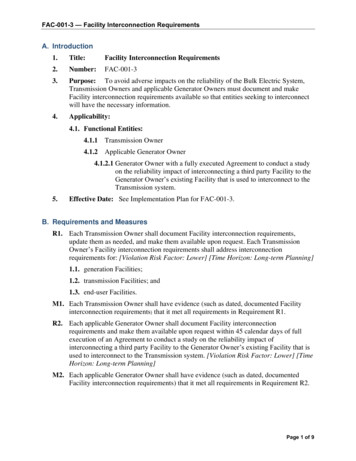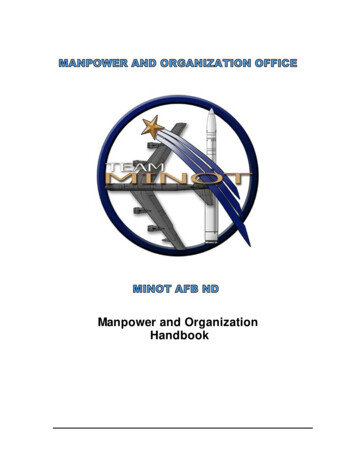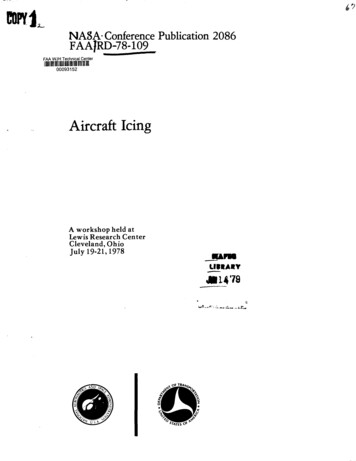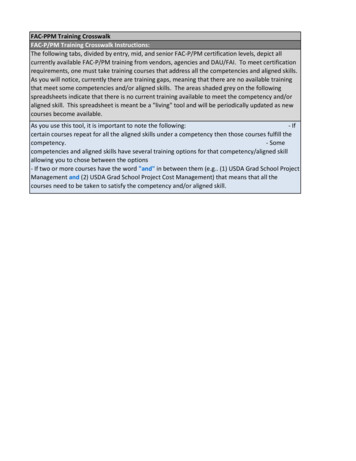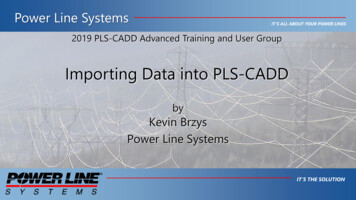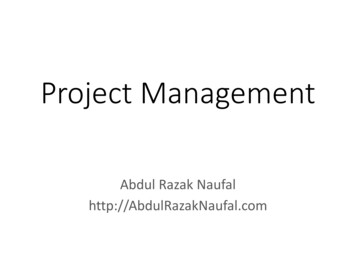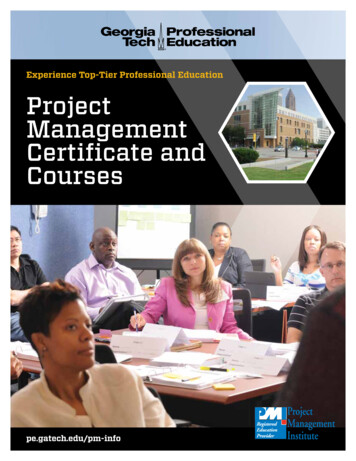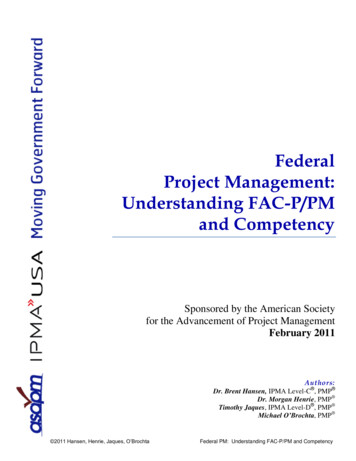
Transcription
FederalProject Management:Understanding FAC-P/PMand CompetencySponsored by the American Societyfor the Advancement of Project ManagementFebruary 2011Authors:Dr. Brent Hansen, IPMA Level-C , PMP Dr. Morgan Henrie, PMP Timothy Jaques, IPMA Level-D , PMP Michael O’Brochta, PMP 2011 Hansen, Henrie, Jaques, O’BrochtaFederal PM: Understanding FAC-P/PM and Competency
Project Management Certification in the US Federal Government, Page iiTable of ContentsTable of Contents .iiExecutive Summary . ivIntroduction . 1Background and Purpose of the Report . 1What Is Project Management? . 2Survey Methodology . 7The Project Manager . 5Project Management Certification . 6Certification Background . 6Certification Attributes . 7FAC-P/PM Certification History . 7FAC-P/PM Implementation . 10FAC-P/PM Certification Requirements . 10Competency Areas . 13Agency Adoptions. 13Case Study: . 14Competency-Based FAC-P/PM Implementation at Veterans Affairs . 14Building Project Management Leaders . 15Evaluating the FAC-P/PM Certification Program . 18Criteria for Evaluation . 18Summary of Findings . 18Finding 1: Program Design and Implementation . 19Finding 2: Reconciling Project Management and Acquisition Lifecycles. 19Finding 3: Lack of Clear Program Metrics . 20Finding 4: Program Awareness . 21Finding 5: Implementation Guidance. 21Finding 6: Impact of the Program . 22Recommendations . 23For The Office of Management and Budget and Federal Acquisition Institute. 23Recommendation 1: Maintain and Evolve the FAC-P/PM Program . 23Recommendation 2: Measure the Results . 25Suggested KPI‟s . 26Level. 26Suggested KPI . 26Recommendation 3: Provide Implementation Guidance . 26Recommendation 4: Develop the FAC-P/PM Community. 27Recommendation 5: Develop Vendor Workforce Certification . 28Recommendation 6: Align Project Management With Industry . 28 2011 Hansen, Henrie, Jaques, O’BrochtaFederal PM: Understanding FAC-P/PM and CompetencyPage ii
Project Management Certification in the US Federal Government, Page iiiFor Federal Agencies . 30Recommendation 7: Focus on Competency, Not Just Training. 30Recommendation 8: Improve Outreach . 30Recommendation 9: Improve Level 1 and 2 Adoption . 32Recommendation 10: Utilize a Framework for Implementation . 32Acknowledgments . 36Contact Information . 39 2011 Hansen, Henrie, Jaques, O’BrochtaFederal PM: Understanding FAC-P/PM and CompetencyPage iii
Project Management Certification in the US Federal Government, Page ivExecutive SummaryProject success ismore important thanever. FAC-P/PMplays a key role inthat success.Mission success is often dependent on project success. The federal government has joined industry in a pattern of increased attention to projectmanagement that includes establishing certification and competencystandards. The Federal Acquisition Certification for Program and ProjectManagers (FAC-P/PM), which was created April 2007, is a work in theearly stages of progress. Its goal of “well-trained and experienced program and project managers” remains intact.This study was conducted to get a glimpse into the status of FAC-P/PM; itis in the early stages of implementation and the pace is accelerating. Implementation seems further along where positive project management andtraining attitudes exist; however, implementation is sporadic and hampered by a lack of a centralized or active inter-agency community. Implementation is also hindered by the relatively sizable effort required byeach Agency to develop their own individual FAC-P/PM programs; this ispresenting a barrier for some. The Senior/Expert level of FAC-P/PM isreceiving virtually all of the attention.FAC-P/PM is a three level competency-based project and program management certification for federal government civilian employees. It includes skills specific to the government environment that are not well represented by industry or commercial certifications. The Office of FederalProcurement Policy (OFPP) within the Office of Management and Budget(OMB) controls the program, the Federal Acquisition Institute (FAI)oversees the program, and the individual agencies are responsible for exercising the wide latitude they have been given to develop and implementcompliant FAC-P/PM programs.Positive reports from adopters of FAC-P/PM have been received for thegovernment-specific aspects, for the inclusion of life cycle system management, and for the inclusion of leadership. The impact of FAC-P/PM onthe management and outcome of projects and programs has not beenmeasured and is likely too early to tell; however, some project managersreport signs of improvement. Study data indicate that higher levels of value are associated with FAC-P/PM where implementation was furthestalong, where there is increased appreciation for project and program management, where certification is based more on competency and less ontraining, and where employees see FAC-P/PM as part of a systematic effort within their Agency to improve project and program results.Project management is an emerging field across many civilian agencies,and, as in any emerging market, there are leaders and followers.OMB and FAI have a tremendous opportunity to harness the power of the 2011 Hansen, Henrie, Jaques, O’BrochtaFederal PM: Understanding FAC-P/PM and CompetencyPage iv
Project Management Certification in the US Federal Government, Page vearly adopters lessons learned and knowledge base for the benefit of thenext wave of FAC-P/PM adoptions.Continuing the FAC-P/PM program and implementations is recommended; study data are suggestive of the program‟s value. Recommendations atthe program level for OMB and FAI include assessing program performance using outcome-based measures, providing Agencies with additional implementation guidance, developing a collaborative inter-agency implementation community, enabling individual Agencies to leverage theexperience of the early adopters, and increasing the awareness of FACP/PM within the program and project management workforce. Recommendations at the Agency level include improving outreach with the earlyadopters, stimulating Entry/Apprentice and Mid/Journeyman levels of certification, focusing more on competency and less on training, and using aframework to plan and guide FAC-P/PM implementations. 2011 Hansen, Henrie, Jaques, O’BrochtaFederal PM: Understanding FAC-P/PM and CompetencyPage v
Project Management Certification in the US Federal Government, Page 1Introduction“OMB and federal agencies have identified approximately 413 IT projects— totalingat least 25.2 billion in expenditures for fiscal year 2008—as being poorly planned,poorly performing, or both.”GAO Testimony Highlights; July 31, 2008GAO-08-1051TBackground and Purpose of the ReportThe FAC-P/PMStudy: Designed ToSupport Better Federal Project ManagementThe purpose of this report is to present the results of a study that has beenconducted of the status of the Federal Acquisition Certification for Program and Project Managers (FAC-P/PM). Since FAC-P/PM is in its earlystages of implementation, this study sought to learn about how it is beingimplemented, to find out about what the early effects might be, and to offer recommendations to aid those involved its implementation. An emphasis of the study was to identify actions that can be used by those who arestill involved in implementing FAC-P/PM.The emphasis on project management in the federal civilian governmentcontinues to increase steadily, supported by a range of mandates and public pressure, and mirrored in the industry and military sectors by at least assubstantial a level of emphasis. This across-the-board emphasis is beingdriven by the increased attention to results and the recognition of the effective role that project management and project management certificationplay in achieving these results.It is understood that the glimpse provided by this study is constrained bylimitations associated with trying to characterize a broad and diverse population that is not aligned with any specific federal occupation series. Thisglimpse is further constrained by the newness of the subject; a limitednumber of people are aware of FAC-P/PM to the degree necessary to offerinformed opinions about it. As a consequence, this glimpse into FACP/PM is partial and incomplete; its accuracy is likely greater for some ofthe pockets within Agencies than others. 2011 Hansen, Henrie, Jaques, O’BrochtaFederal PM: Understanding FAC-P/PM and CompetencyPage 1
Project Management Certification in the US Federal Government, Page 2What Is Project Management?At its core, project management is a structured discipline that is focusedon achieving project results. Projects are defined as “a temporaryendeavor undertaken to create a unique product, service, or result1 .” Thisdefinition highlights the fact that projects are timebound and involveschedules. It also highlights the fact that projects are undertaken toachieve something unique. An important consequence of projectuniqueness is risk; generally speaking, the more unique the project is, themore significant a role risk plays in project success. Project managementplaces considerable emphasis on planning for those risks, executingaccording to the plan, and controlling/monitoring the scope and resources.A Multi-Modal StudyProjects are fundamentally different from the type of work commonlyreferred to as maintenance and operations where work has more of arepetative nature. Organizations are invariably involved with a mix ofproject work and operations work. Processing claims at the SocialSecurity Administration is an example of operations work; upgrading theclaims processing system is an example of project work.The larger the portion of project work done in the organization, the morelikely the organization will reap the benefits of adopting project management. There are some solid connections between project management andother successful management approaches that have been used includingManagement By Objectives (an outcome-based process), Six Sigma (aquality management strategy), and Business Process re-engineering(focused on work flows).Project managementuses techniquesfrom other disciplines.1Project management has successfully imported elements from theseapproaches and focused them on the temporary and unique aspects ofprojects. Projects in the federal civilian government can span a very broadrange of work including, for example, a one-week effort to re-layout aDepartment of Transportation jobs web page to correspond to relatedchanges on other web pages; a six-month endeavor at the Department ofInterior Bureau of Land Management to revise their Wild Horse and Burro Strategy Development Document; to a multi-year undertaking at theFederal Bureau of Investigation to develop and deploy their Next Generation Workspace.The Project Management Institute has published a widely accepted definition in the American NationalStandard Institute ANSA/PMI 99-001-2008 document titled A Guide To The Project Management Body OfKnowledge – Fourth Edition. 2011 Hansen, Henrie, Jaques, O’BrochtaFederal PM: Understanding FAC-P/PM and CompetencyPage 2
Project Management Certification in the US Federal Government, Page 3Survey MethodologyThis study involved interviewing federal civilian employees with knowledge about how project and program management is practiced within their Agencies, surveying federal civilian employees and contractors involved in federal civilian projects and programs, examining available literature, drawing upon commonly accepted practices, anddrawing upon available FAC-P/PM expertise.Interviews were conducted with: Central Intelligence Agency, Department of Commerce, Department of Energy,Department of Homeland Security, Department of Treasury, Federal Acquisition Institute, Federal Bureau of Investigation, General Services Administration, Office of Federal Procurement Policy, Office of Management andBudget.A survey was released to the membership of the Washington D.C. chapter of the Project Management Institute; responses received from 57 employees involved with federal civilian project management were equally split betweenfederal and contractor employees.U.S. Federal Government has long relied on project management.Project management is being applied within aerospace, the military,health care, information technology, intelligence, as well as many otherfields. This broad range of project work extends into virtually all cornersof the government and involves a significant amount of effort; federalspending on information technology projects alone in fiscal year 2011willtotal 79.4 billion2.Project management is key to achieving project success. Studies have repeatedly shown that the benefits of project management include improvedcost performance, improved schedule performance, greater predictability,higher probability that what is delivered meets the needs, increased customer satisfaction, and improved employee retention3. In the federal government, mission success is increasingly dependent on project success.Project management has been alive and well in the federal workforce inthe United States for more than sixty years. In fact, some of the earliestadopters of the discipline of project management worked on governmentprojects; in the late 1950‟s the Program Evaluation and Review Technique(PERT) for assessing project performance was developed as part of theNavy‟s Polaris missile program. In the mid 1970‟s, the Office of Management and Budget (OMB) issued Circular A-109, the first federal directive to address program management.2The OMB report titled Analytical Perspectives – Budget of the U.S. Government – Fiscal Year 2011 contains financial information about information technology and other large federal projects.3The 2002 book by W. Ibbs & J. Reginato. titled Quantifying the Value of Project Management contains researchresults that show project schedules and project costs averaging 20-40% lower for projects that employ mature project management and that the probability of their actual schedules/costs equating to what wasplanned is more than doubled. The 2002 book by J. Pennypacker titled Justifying the Value of Project Management contains study results that show improvements to a broad range of metrics attributed to project management including a 34% growth in sales, a 33% growth in customer satisfaction, and a 36% growth in employee satisfaction. 2011 Hansen, Henrie, Jaques, O’BrochtaFederal PM: Understanding FAC-P/PM and CompetencyPage 3
Project Management Certification in the US Federal Government, Page 4This document solidified the role of Cost and Schedule Control SystemCriteria (C/SCSC) and set the stage for the establishment, a decade ago, ofEarned Value Management System standards4. OMB Circular A-11,which has been in use since 1997, contains specific requirement in Part 7for the planning and management of projects including in the 2010 release, the requirement to establish and manage cost/schedule/performancebaselines for information technology projects.More recently, official actions have highlighted the recognition of the importance of project management when, on February 18, 2009, as part ofthe national approach to addressing the economy, the Director of OMBissued “Initial Implementing Guidance for the American Recovery andReinvestment Act of 2009.” This sixty-two-page document contains manydozens of very specific actions and responsibilities associated with projectmanagement to ensure that “specific program outcomes and improved results” are achieved.The federal projectmanager’s role isevolving.This history of project management in the federal government is reflectedin core regulations including the Federal Acquisition Regulations (FAR).This history shows project management evolving from an enabler for andsubset of successful acquisition to what is increasingly recognized as acomplementary field. The performance-based trends within the federalsector are increasing the role from what is described somewhat passivelyin the FAR as contract administration and oversight to a much more activerole of managing performance5. While project management may oncehave been viewed mostly within the bounds of acquisition, it is now increasingly understood that project management has significant applicationfor non-acquisition efforts as well, and that acquisition, in some circumstances, can be viewed within the bounds of project management. Indeed,acquisition is recognized as but one of the important nine knowledge areas in the PMBOK Guide6.4On August 17, 1999 the Department of Defense (DoD) adopted the ANSI/EIA-748-A (American NationalStandards Institute / Electronic Industry Association) Earned Value Management System (EVMS) standard;adoption by civilian federal agencies followed. The 2010 IMB Center for The Business of Government reporttitled Project Management in Government: An Introduction to Earned Value Management (EVM) by Y. Kway andF. Anbari describes the practices and trends in EVM and provides suggestions for increased adoption.5The Acquisition Central web site for the federal acquisition community www.acquisition.gov includes theSeven Steps to Performance-Based Acquisition with the management of performance identified as the most important step.6The Project Management Institute publication titled A Guide To The Project Management Body Of Knowledge –Fourth Edition, which is a widely accepted standard commonly referred to as PMBOK Guide, identifies project procurement management as one of the nine knowledge areas. 2011 Hansen, Henrie, Jaques, O’BrochtaFederal PM: Understanding FAC-P/PM and CompetencyPage 4
Project Management Certification in the US Federal Government, Page 5The Project ManagerThe sheer number and skill levels of project managers in industry havegrown in response to the increased importance of project management7.Likewise, the numbers of federal civilian employees performing projectmanagement duties has increased as well8.Increased demandand complexity ofprojects has increased the criticality of the projectmanager role.However, this increase is occurring at a time when achieving success isstill a difficult goal9. One look into troubled projects like the SBInet atDepartment of Homeland Security, Deepwater at the Coast Guard,handheld devices at the US Census Bureau, or the Sentinel case file system at the Federal Bureau of Investigation, highlight the underlying obstacles to success. GAO recently reported that competence in project andprogram management is a critical factor to the success of those efforts.10.The project manager‟s role is so critical to the success of the project thatthe OMB Circular A-11 Exhibit 300 now requires the name and qualifications of the project manager. The definition of acquisition has even beenexpanded; for the first time it officially includes project managers11.Just as industry has placed an increased emphasis on project-related work,the federal civilian sector has mirrored industry by building training programs and career paths for project managers. Although no federal Standard Occupational Classification has yet been established for project management, certain job classifications such as GS-2210 IT Project Managerdo now include important aspects of project management, and interpretiveguidance has been issued for project manager positions12.7The Project Management Institute (PMI), as the largest professional project management professional association in the world, reports a total of more than one half million members and credential holders; membership growth has averaged more than 20% per year for the past decade.8Congress enacted section 869 of the Duncan Hunter National Defense Authorization Act for Fiscal Year2009 that directs OMB to prepare an Acquisition Workforce Development Strategic Plan for federal agenciesother than the Department of Defense to develop a specific and actionable 5-year plan to increase the size ofthe acquisition workforce. FAI 2008 Annual Report of the Federal Acquisition Workforce states that there were1,756 program and project managers on 12/31/08 in the civilian agencies, an increase of 89% from the previous year. While this report substantially underreports the actual number of federal civilian project management employees, internal counts in some individual agencies are larger than the FAI reported total, itdoes reflect the growth trend.9The Standish Group report dated April 23, 2009 titled CHAOS Summary 2009 shows more failing projectsthan previously, with only 32% of projects succeeding on time, on budget, and with the required features.10See for example: GAO-09-620T Coast Guard Deepwater, GAO-07-518 Department of Energy project management practices, GAO-08-79 US Census Bureau information technology management, GAO-06-698T Federal Bureau of Investigation Sentinel case file system, or GAO-05-819T satellite programs in the IntelligenceCommunity.11The Services Acquisition Reform Act of 2003 (SARA, P.L. 108-136) expanded the definition of acquisition workforce to include project and program managers.12The Office of Personnel Management (OPM) created the GS-2210 IT Project Manager position and issuedthe document titled Interpretive Guidance For Project Manager Positions in August 2003. 2011 Hansen, Henrie, Jaques, O’BrochtaFederal PM: Understanding FAC-P/PM and CompetencyPage 5
Project Management Certification in the US Federal Government, Page 6Project Management Certification“Well-trained and experienced program and project managers are critical to the acquisition process and the successful accomplishment of mission goals."Office of Federal Procurement Policy, April 25, 200713Certification BackgroundFAC-P/PM is nearlyfour years old.In response to this situation, for the first time ever, civilian employeesnow have the opportunity to earn a certification in project and programmanagement that was created specifically for them. This new certificationcredential, the Federal Acquisition Certification for Program and ProjectManagers (FAC-P/PM) was put in place by the Office of Managementand Budget (OMB) because according to the April 25, 2007 OMB memorandum for Chief Acquisition Officers from the Administrator of the Office of Federal Procurement Policy (OFPP) "Well-trained and experiencedprogram and project managers are critical to the acquisition process andthe successful accomplishment of mission goals."This focus on meeting mission goals through the efforts of program andproject managers underpins the FAC-P/PM certification. It spotlights theconnection between skilled program and project managers and the effectiveness of the acquisition process within their Agency. Now civilian federal government employees have an opportunity to earn not only industryaccepted credentials such as those from the International Project Management Association (IPMA) and from the Project Management Institute(PMI), but also a FAC-P/PM credential that includes elements of particular relevance to them as federal employees14.13Memorandum for Chief Acquisition Officers from OMB Office of Federal Procurement Policy (OFPP) datedApril 25, 2007.14Project management and program management credentials are available from the International ProjectManagement Association (IPMA Levels A-D) and from the Project Management Institute (Project Management Professional, Program Management Professional.) 2011 Hansen, Henrie, Jaques, O’BrochtaFederal PM: Understanding FAC-P/PM and CompetencyPage 6
Project Management Certification in the US Federal Government, Page 7Certification AttributesKnowledge basedcertificationsabound.Certification is a well-established approach to helping employees validatethat they possess desirable competencies associated with particular job requirements. Some certifications even go beyond the lower levels of learning such as knowledge and understanding of a subject to actually encompass higher levels of learning to include the application of theknowledge15. An example of this important distinction of learning levelsare the differences between knowing what a project plan is, comprehending the significant contents within a project plan, being able to applyknowledge to write a project plan, and performing analysis to determinehow the project plan can be tailored to the particular situation.Some certifications reflect these levels of learning by offering levels ofcertification; each of the levels can correspond to higher levels of learningand they can correspond in project management, to larger, more complex,and higher risk projects.The basis for granting a certification can play a key factor in determiningthe value of the certification. Certifications with minimal effort can be obtained through longevity, by attending training, by recasting previous experience, or some combination. Certifications requiring increased effortcan involve passing tests, demonstrating on-the-job performance, pier reviews, or some combination. The largest grantor of project managementcertifications in the world uses a combination of documented experienceand applied knowledge as the basis for their certification16.FAC-P/PM Certification HistoryAs a result of OMB‟s Office of Federal Procurement Policy Letter 05-01dated April 15, 2005, the Federal Acquisition Institute (FAI) formed across-functional working group and developed recommendations for the“establishment of certification programs for program and project managers ” That policy letter, which provided the rationale for establishing aspecial government certification, stated that the action is being taken tobuild on “previous efforts to improve the development of the acquisitionworkforce” by addressing the broadened definition of acquisition contained in the Services Acquisition Reform Act of 2003 (SARA, P.L. 108136). For the first time, the Acquisition role now includes “program andproject managers.”This is a significant expansion, and means that civilian federal government program and project managers are part of the acquisition
The Federal Acquisition Certification for Program and Project Managers (FAC-P/PM), which was created April 2007, is a work in the early stages of progress. Its goal of "well-trained and experienced pro-gram and project managers" remains intact. This study was conducted to get a glimpse into the status of FAC-P/PM; it
